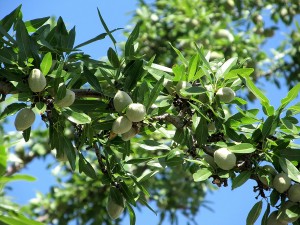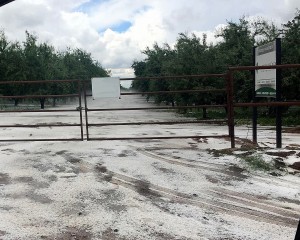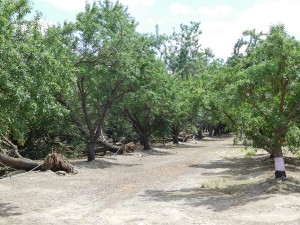
Director, Member Relations
This report covers conditions and observations made between Monday, April 4 and Sunday, May 1, 2016.
Northern Region –
Observers reported typical spring conditions during April, with periods of rain mixed in with dry, bright sunny days. Daily maximum temperatures during the dry days at the start of the period and at mid-month ranged from the mid 70’s to upper 80’s. At other times, most notably between the 9th and 15th , and again from the 22nd through the 28th, readings topped out in the upper 60’s to lower 70’s as showers swept over the region. Morning lows for the period were reported predominately between the upper 40’s and mid 50’s. Total rainfall accumulations for the month ranged from a few hundredths of an inch to as much as 1.5 inches. Observers are reporting that winds were the most dominant weather factor during the month, with speeds reaching into the teens on many days during the period. While disrupting some operations, growers in the Sacramento Valley reported that their orchards escaped significant damage from the winds, unlike those in San Joaquin.
Observers are reporting that the 2016 crop is developing well, with no signs of disease. Growers concentrated primarily on pest management and irrigation during the period. Treatments to prevent fungal diseases, made necessary by the rain, were also completed during the calmest days of the period in orchards with a history of disease on susceptible varieties. These treatments must be applied prior to the start of infection as once fungal growth has begun, controls are no longer effective. Growers have also been mowing vegetation to reduce water use.
Some growers have noted that the water levels in their wells have rebounded during the past winter, a benefit of the rain the region has received. Observers have noted that while the irrigation season has begun, the rain received during April did help to delay the need for irrigation in the wettest areas. The winds that blew through the valley also complicated matters for growers who worked to time irrigation’s to avoid the windiest days, thus reducing the possibility of blown over trees. Along with irrigation, growers have also been applying fertilizer materials to support the crop and promote spur development needed for the 2017 crop.
As the crop continues to grow, kernels have begun to solidify and observers are reporting that the trees have been shedding nuts they are unable to carry to harvest.
Central Region –
While conditions during April were generally very supportive for the development of the 2016 crop, the period also brought a few days of adverse weather. Daily maximum temperatures varied widely, reaching into the mid and upper 80’s during the period’s opening week and again at mid-month. In between, readings ranged from the lower 60’s to mid and upper 70’s with coolest readings coinciding with the period’s wettest days. Morning low readings were a bit more stable, ranging predominately between the mid 40’s and mid 50’s.
Rain swept over the region on several days during the month, with the wettest periods recorded on the weekend on April 8-10. Though there were a few other brief, showery days, the month’s strongest storm built over the region on Wednesday, the 27th when thunderstorms brought strong winds, heavy rain and hail to areas of San Joaquin and eastern Stanislaus counties. Total rainfall accumulations for the period ranged from trace amounts to as much as 3.0 inches from the heaviest downpours. While there were some windy days during the period, with speeds reaching into the teens, the period’s strongest winds were recorded on the last weekend of the month, when gusts reached in excess of 35 mph.
The 2016 crop continues to develop in the central region, with only a few impacts from the adverse weather experienced during the final week of the month. Hail that fell in areas of San Joaquin County, from Manteca to Escalon caused few problems for growers in its path. However, heavy accumulations of larger hailstones that struck the area from Oakdale, south to Waterford and Hickman in eastern Stanislaus County did cause some nut loss and tree damage. Nuts damaged by the hail will continue to fall over the coming weeks.
Growers spent the period focused on irrigation and pest management. Deliveries of surface water have begun from local irrigation districts. While allocations of water from the federal Central Valley Project remain at 5% of contracted amounts, allocations from the State Water Project have been increased to 60%. Observers have reported that the irrigation season has begun in all areas of the region, though many growers have been able to delay irrigation as a result of the rain the region has received.
Growers in some areas of the region have reported increasing populations of Leaf-Footed Plant Bugs, which can cause severe damage to the crop through its feeding on the developing nuts. A few growers have reported that populations had built to the point requiring treatment. Growers are also watching populations of Peach Twig Borer, using pheromone traps to monitor the insect’s life cycle in order effectively time any control measures required.
Observers are reporting that the region’s orchards are growing heavy under the weight of the developing crop. Kernels have begun the solidification process, transitioning from a clear gel into a solid almond meat. Nuts that trees are unable to carry to maturity have nearly all been cast to the ground, a process that was aided by the blustery winds in the period’s final days.
Southern Region –
Mild to warm conditions reigned over the southern San Joaquin during much of April. However, periods of rain and blustery winds also impacted the region, soaking orchards and blowing over trees in some areas. Daily maximum temperatures in the opening days of the period and at mid month reached into the mid and upper 80’s in the warmest areas of the region. Meanwhile, readings topped out in the upper 60’s to lower 70’s between the 8th and 16th and again in the period’s final week as more inclement conditions prevailed. Morning low temperatures were widely reported between the upper 40’s and upper 50’s throughout the period.
As shown in the photos accompanying this report, winds that accompanied the stormiest days of the month, when as much as 1.5 inches of rain was reported, created problems for some growers. In the southern areas of the region, winds that were reported in excess of 40 mph in areas of Tulare and Kern counties knocked nuts to the ground in many orchards and blew over trees in older plantings. While inflicting serious damage to the impacted orchards, the damage to the crop as a whole did not reach significant levels. Meanwhile, thunderstorms in the northern areas of the region during the last week of the period dropped hail and locally heavy rain in areas of Madera County. While accumulations were fairly impressive, observers have reported little to no damage to the crop.
Observers have noted that while the conditions described above provided challenges for some areas of the region, the normal phases of crop development continue. Nuts are now fully sized and beginning to solidify; those that trees are unable to carry to maturity have been shed to the ground. Growers have been busy mowing vegetation within the orchards and irrigating as needed, working to avoid the windiest days to prevent blown-over trees. Some growers have also taken advantage of the calmest days to complete treatments to control Peach Twig Borer and Navel Orange Worm as determined by trapping to monitor the insect’s life cycles. Treatments have also been made in plantings where populations of Leaf-Footed Plant Bugs have built to damaging levels. Some growers have also begun treatments to control rust and scab, which can arise as a result of the damp conditions experienced during the month.
Observers have reported that orchards in areas that exhibited the greatest degree of stress from lack of water and/or excessive salinity over the past year have recovered well and are presenting new growth. While crop loads are running below normal, the rain received during the past winter appears to have aided these plantings and allowed them to recover somewhat from the adverse effects they have endured. Increased allocations of water in some areas of the region may provide additional relief as growers blend ground water with better quality water from surface deliveries. However, given that allocations from the federal Central Valley Project remain at 5% of contracted amounts, many growers remain largely dependent on groundwater of questionable quality. As a result, impacts on orchards in these areas can be expected to continue.
The next scheduled report will be posted on Monday, June 6, 2016. In the event of any significant occurrences prior to that date, this site will be updated as soon as possible.


